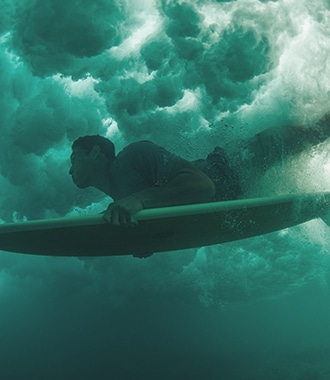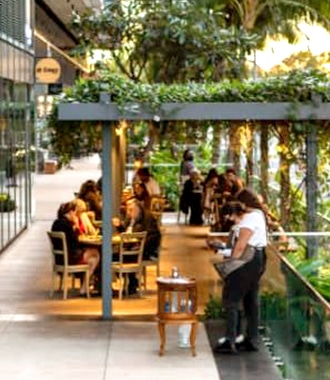Beauty and the Beach

Salvage Public made their initial debut in 2013 with the launch of a small collection of graphic T-shirts. It was a side project for co-founders Joseph Serrao, Noah Serrao, and Nāpali Souza. Joseph had just moved back home to O‘ahu from L.A. and linked up with his old high school friend, Nāpali Souza. From this solid creative core, the trio put their focus into building new collections and developing Hawai‘i-centric narratives around the styles. Soon, the brand came to represent an iconic facet of the Hawaiian way of living—an authentic representation of Hawai‘i’s love and respect for the natural world and the aesthetics that arise from its cultural diversity. We caught up with Joe to talk about the brand’s vision, its success in the Japanese market, and the colorful scene at South Shore Market.
Can you share the meaning behind the name?
Salvage is like holding, like saving things for ourselves or holding onto things we like about Hawai‘i—what we feel is a little unique or different than what’s been portrayed in the past. Public is because we want to share this brand with everyone. So our collections takes on different vibes of traditional Hawaiian sensibilities with ‘ōlelo or song lyrics. We touch 1980s and ’90s Hawai‘i, too, with color schemes and imagery that we’re pulling that inspire us. Last season we did a bunch of ’90s-esque graphics and colors.
How did you set your brand apart from others in the competitive surfwear market?
The surfwear market has been saturated for a while, but we’re just on the fringe of being surf-inspired. We never considered ourselves to be a surf brand. We weren’t going to sponsor kids or do contests. Our focus was the messaging of the brand and the storytelling. It’s more overall on the fashion side, too. The fashion market is also saturated, but there’s uniqueness to be found when you have cultural brands pushing messaging.
What messaging has Salvage Public been focused on?
We’ve been talking about ‘āina rights, which came out about six months ago. ‘Āina rights has two ways to look at it. There’s a law case where they gave legal rights to a river—what that means for land to have its own rights and taking care of it. It’s engrained in Hawaiian culture, to take care of the land and do right by it. We’ve been playing with that phrase as a graphic. It also came out when we developed the hemp T-shirt. It coincides with aloha ‘āina, which people are very familiar with. Aloha ‘āina and ‘āina rights is love of the land. Hemp is a sustainable product. It’s at the top of the list. The water usage is so low for hemp as a crop and it grows quickly, so we’ll be developing out that product further in our sustainability category, which pairs up with ‘āina rights.
How important is collaboration with other creatives to the overall success of Salvage Public?
We’re a small team, but we’re small enough to do things in-house on-island. Where collaboration comes into play is internationally. In Japan, we do quite a bit of collaboration with our distribution sales team. We have about 150 stores in Japan that we work with on a seasonal collection calendar. A good amount we go into with a special makeup, exclusives, and that’s when the collaborations happen. We do exclusives for almost every huge store in Japan, which happens very easily nowadays with all the technology. I also go to Japan every couple months and the Japan distribution team comes here every two months. Nothing beats face-to-face meetings and what we can accomplish in that.
How did you connect with the Japanese market?
We got lucky. By the end of our first year with the brand, we had about 10 different distributors in Japan that wanted to work with us. We met with them all and made a selection of what was the best fit for us. In Europe, we’ve had struggles with distribution. But Japanese culture and Hawai‘i culture are so closely related in some ways, we work with them as we work with family here. It’s an easy relationship.
What are your plans for the future with Salvage Public? What can we look forward to in the years to come?
We have a big pop-up that we’re doing in Japan with a store called Isetan. It’s like one of the biggest department stores in the Tokyo area. We have a pop-up in April on their first floor. We have exclusives that we’ll be designing for that pop-up, which will also be in the South Shore Market location. Anytime we do these specialty exclusives, we’ll also carry them in our Hawai‘i stores as well. That’s going to be a really big pop-up.
What has been your experience as a small business owner with a retail store at South Shore Market?
We all love working at South Shore Market. I love it personally. The location is great. The more and more you think about Hawai‘i and where you’re neighborhood is, Ward Village has done a great job—South Shore Market is one of those places where people can relax and hang out. There’s a local vibe with the storeowners. I can catch up with my neighbors and actually connect with them. It has a local feel and it has that elevated look to it. The location has that modern aesthetic of being a small little city of itself—the architecture, it really grabs a hold of us. You can seek out the places you want to go and you can make a day out of it at the beach park across the street. That was a factor for us to be there. You gotta give love to Ala Moana Beach Park with these great Town surf breaks, and it’s a great place to hang out. There’s a local scene happening and I love that.






